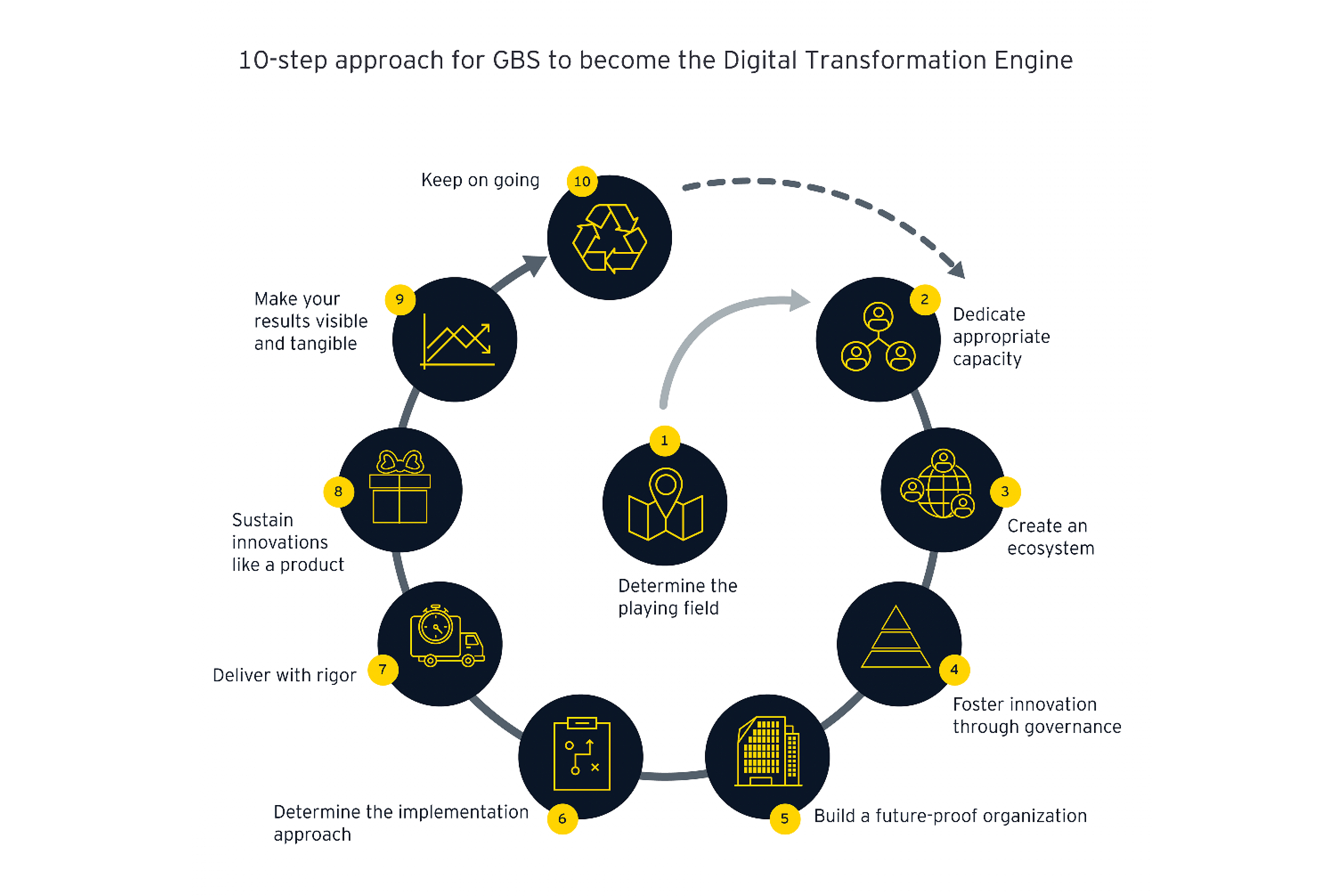1. Determine the playing field
Don’t start with technology – why buy a screwdriver when you don’t know whether the screws are loose? Instead, start with identifying the most promising opportunities. There are two routes. Work with your key stakeholders to identify process areas with the most promising potential (ones that GBS currently operates, or that key stakeholders perform and see an opportunity for GBS to innovate within them). Or use your current process scope as a starting point and identify areas of potential opportunity there.
Tip: Create a simple grid of process areas, business units and geographies, linked to the expected outcomes from your business counterparts.
2. Dedicate appropriate capacity
GBS organizations have relatively large FTE footprints compared to in-market teams. So there should be sufficient potential to free up capacity. The 70/20/10 principle devised by Charles Jennings can also be applied here, with 70% of GBS capacity dedicated to operations, 20% on continuous improvement and 10% on transformational innovations. For a digital transformation engine, even a 80/18/2 ratio could suffice. Your team should be made up of professionals who know your organization, understand its processes, are technology savvy and curious, show interest in innovation or disruption, and are comfortable with failing fast. The team needs be appraised (or even remunerated) based on their contributions to digital transformation, not the number of tickets closed or invoices processed.
Tip: Recruit team members based on specific process knowledge, or organically assign people based on their preferences and professional interests.
3. Create an ecosystem
Building an ecosystem of partners, including technology vendors and disruptive start-ups, can help GBS innovate to deliver value in a structured and sustainable way. One route is to depend on in-house capabilities for mission-critical processes but invite third-party providers to co-innovate and co-develop your digital transformations. For less essential process areas on the other hand, develop the strategy together with your ecosystem, encourage them to bring you new ideas about additional process areas or improvements on your previous innovations.
Tip: Focus on bringing in specific technologies, while building up digital transformation capabilities and resources in-house.
4. Foster innovation through governance
It’s important to have the governance in place to identify and prioritize your best digital transformation bets. A typical three-tier governance structure should have a top tier as an innovation steering committee (with an IT representative involved), a middle tier with GBS leadership or the Global Process Owner empowered to influence decisions, and a bottom tier to perform end-to-end processes and ensure customer-centricity in all innovation ideas.
Tip: Encourage your digital transformation engine to bring promising ideas to the two top layers for approval, prioritization and implementation.
5. Build a future-proof organization
Building a future-proof organization has implications on the structure of the GBS organization, governance mechanics, talent management, and even the geographic footprint. Skills such as design thinking, advanced analytics, data science, coding and programming are a necessity. New digital process platforms will cover a larger portion of end-to-end processes, which should encourage GBS organizations to deploy teams that can operate the entire chain and keep technology solutions and data models running. The deployment of digital transformations is faster, more straightforward and more successful in companies with a process ownership structure in place.
Tip: A networked global structure allows for better global resource allocation and mirroring end-to-end team structures.
6. Determine the implementation approach
Your disruptive and innovative ideas may encounter pushback from the organization, but applying a customer-led transformation approach can help you flatten this speedbump, if not jump over it. Technology end users, customers, business counterparts, applicants, or even government agencies should be involved in the design and deployment of your digital transformations.
Tip: Use SIPOC to examine each future process component and ensure each output is actually needed and meets the customers’ requirements without wasting effort and cost.
7. Deliver with rigor
Resources are finite, ROI is expected and quality is king if a GBS organization is to remain relevant. One of the frequent failures we have seen is an underequipped GBS employee trying to balance a "reduced" (read “full time”) operations workload while trying to provide support on a large-scale project or program. This leads to operations suffering with increased backlogs. Using Agile principles and structures will help create and sustain a continuous discovery, delivery and deployment pipeline.
Tip: Focus on delivering value in every iteration, work in small teams in short cycles, and empower team members to make decisions.
8. Sustain innovations like a product
You will need take a product view and have a corresponding governance structure to make your innovations stick. A product-owner view on innovations is vitally important considering the recurring nature of process innovations in GBS, and handing innovative ideas over to the business should become a habit within the corporate DNA. GPOs tie the digital transformation engine together with (GBS) operations, continuous improvement teams and end users, thereby maintaining, improving and championing the innovation like a product.
Tip: As soon as an impactful process innovation is successfully deployed in the organization, it will need to be maintained and continuously improved for it to become future-proof. Members of the digital transformation engine team could be suitable candidate for product owner roles.
9. Make your results visible and tangible
Many GBS organizations have benefited greatly from a GBS landing page, customer portal, traditional intranet sites or knowledge-sharing databases, to easily communicate their performance and what they are currently working on. Innovative GBS organizations host “art of the possible” sessions for business counterparts to present latest internal and external insights on innovation possibilities and technologies. You could, for instance, use internal social media and community channels as a distribution network to celebrate success. In this way, communication is consciously decentralized, enabling a wider variety of adaptive two-way communication channels, and allowing proud adopters of the new innovation to share their experiences across the organization.
Tip: Sharing success stories and experiences is a valuable way of giving back to your ecosystem or wider GBS practitioners community, and it might result in additional innovative ideas or propositions to team up.
10. Keep on going
To maintain the engine you’ve built, and add new engine blocks and cylinders to keep stakeholders happy, simply revisit steps one through nine. It is crucial to keep going and make sure digital transformation wasn’t just a surge but becomes the new normal. Looking into what could be next, you might want to consider that team members will ultimately move on, new technologies will make parts of your ecosystem obsolete and your digital transformation engine is only as good as its last transformation.
Tip: Continue to build a track record of undisputed success for your digital transformation engine: be transparent about the process areas it has picked up, which digital process platform it has transformed into, how it benefits the wider organization, and how it works for its end users.



